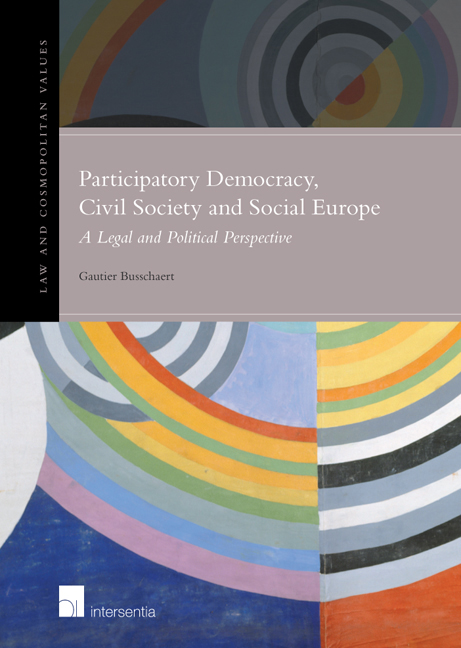Book contents
- Frontmatter
- Acknowledgements
- Contents
- Abbreviations
- Chapter 1 Democratic EU: from Representation to Participation
- Chapter 2 Reviewing the Participatory Ideal of Bits and Pieces
- Chapter 3 Overcoming the Participatory Ideal of Bits and Pieces
- Chapter 4 Revisiting the Fundamentals of Internal Market Law
- Chapter 5 Revisiting the Fundamentals of European Competition Law
- Chapter 6 The Civil Dialogue – A Magic Cure for the Democratic Ailments of the Community Method?
- Chapter 7 The Open Method of Coordination – Radicalising Participatory Democracy in the EU?
- Chapter 8 Looking Back – Moving Forward
- Table of Legislation
- Table of Cases
- Bibliography
Chapter 1 - Democratic EU: from Representation to Participation
Published online by Cambridge University Press: 22 September 2018
- Frontmatter
- Acknowledgements
- Contents
- Abbreviations
- Chapter 1 Democratic EU: from Representation to Participation
- Chapter 2 Reviewing the Participatory Ideal of Bits and Pieces
- Chapter 3 Overcoming the Participatory Ideal of Bits and Pieces
- Chapter 4 Revisiting the Fundamentals of Internal Market Law
- Chapter 5 Revisiting the Fundamentals of European Competition Law
- Chapter 6 The Civil Dialogue – A Magic Cure for the Democratic Ailments of the Community Method?
- Chapter 7 The Open Method of Coordination – Radicalising Participatory Democracy in the EU?
- Chapter 8 Looking Back – Moving Forward
- Table of Legislation
- Table of Cases
- Bibliography
Summary
INTRODUCTION
The crisis surrounding the ratification of the Maastricht Treaty signalled the end of the permissive consensus of the public in favour of deeper European integration. After the Danish ‘no’ and the French ‘petit oui’, the governing elite came to realise that the passive approval of the masses for the European project could no longer be taken for granted. These events were interpreted as the signs of a growing crisis of legitimacy. European public opinion had voiced its discontent as to the current state of European integration: something was definitely wrong with the EU. European studies took a normative turn, with scholars expressing diverse, and sometimes conflicting, opinions as to the symptoms, diagnoses and cures they found most appropriate for the sick EU patient.
REPRESENTATIVE DEMOCRACY AND THE COMMUNITY METHOD
The perception which prevailed at the time of Maastricht was that the EU suffers from a democratic deficit. This deficit may be variously defined, depending on the democratic ideal chosen. The standard view was that this is caused by ‘the absence or underdevelopment of the institutions and processes of parliamentary democracy at the European level’. The democratic deficit literature was dominated by ‘the parliamentary model’: government should emanate from and be responsible before an elected parliament. The EU's original sin, therefore, laid in the gradual transfer of powers to the EU which had empowered executives at the expense of national parliaments. With the disease identified as ‘deparliamentarisation’ at the national level, the cure seemed plain and simple: constitutional mimetism, as if turning the EU into a parliamentary democracy modelled upon those of its Member States would solve its democratic deficit.
Since then, the parliamentarisation of the EU has been associated with the rise of the Community Method (CM) seen as the joint exercise of legislative power by the Council and Parliament on a proposal of the Commission. Treaty after Treaty, the co-decision procedure has been extended to an increasing range of fields. With the Lisbon Treaty, it has become the ‘ordinary legislative procedure’ applicable in all cases where the Treaties do not provide otherwise. National parliaments have also emerged as proper actors in the EU law-making process, with a right to receive information directly from European institutions and a direct role in checking that the latter respect the principle of subsidiarity.
- Type
- Chapter
- Information
- Participatory Democracy, Civil Society and Social EuropeA Legal and Political Perspective, pp. 1 - 16Publisher: IntersentiaPrint publication year: 2016



